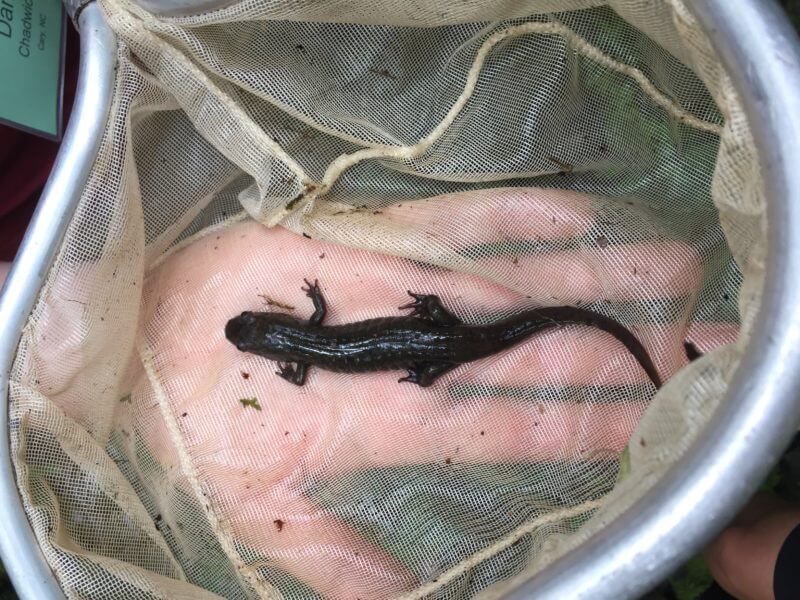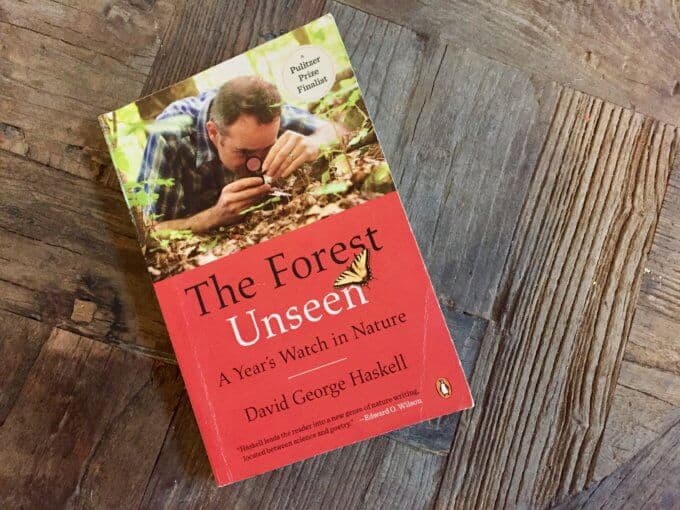
It’s easy to feel like a kid again during naturalist courses, hunting for salamanders in creeks.
It’s one thing to go on a hike and feel rejuvenated through the meditative act of putting one foot in front of the other; however, my naturalist studies have made our wild places feel like old friends as I’ve learned more about them. Everything I encounter weaves together into a symphony of life and sustainability, further validating the importance of keeping these places protected.
Because of my courses, I’ve developed a stronger appreciation for non-fiction books that pertain to my burgeoning naturalist skills. I’d like to introduce my readers to some of my favorites, in hopes that it might encourage to you develop a deeper relationship with the natural world too. It felt particularly fitting to start with David Haskell’s book, a Pulitzer Prize finalist, The Forest Unseen: A Year’s Watch in Nature.
Haskell is an accomplished naturalist who teaches biology and environmental studies at Sewanee: The University of the South. The book centers around a square meter of old growth forest he visits over the course of a year. He calls the spot in the forest a “mandala,” inspired by the artistic practice of Tibetan monks, reminding us that there is no permanency to life. On the surface, the premise may sound mundane. What could change significantly in one square meter of the forest throughout the seasons? More than meets the eye, or perhaps everything that meets the eye, if you know how to look for it.
This is not a book to be devoured in one sitting, but rather to be savored through the seasons. Haskell gently guides you into the woods every few days, as every good naturalist does, to “see what there is to see.” The style of his writing borders on poetry in many places. Consider the entry on September 21 which starts with, “I feel a powerful sense of delight in the morning’s strong sun. My spirits were lifted by the sight of a dozen migrant warblers bathing in the stream that crosses my path to the mandala. They stood in shallow stream pools, dipping and shaking their bodies, feathers fluffed out. Each bird raised a halo of silvery flashing water drops. They seemed to baptize themselves with sunlight.” Aaah, can’t you just feel your blood pressure lowering after you read that passage?
Haskell’s other great gift is that of teacher. Acquiring naturalist skills is an infinite exercise, and there is such a wealth of information to be gleaned from the pages of this book that I have found myself reading sections of it over and over. I then take these stories into my own circles of education. My kids especially enjoyed learning about Turkey Vultures and how their olfactory bulbs can confuse the smell of a decomposing corpse with a propane leak, since both emit a chemical compound called ethyl mercaptan (it’s added to odorless propane so leaks can be identified quickly). Fun little nuggets like this stick with them and foster an interest in learning more about the natural world.
In a world which increasingly values instant gratification, Haskell’s exercise in the forest illuminates the reward of patience, that the complexities of life are best taught slowly, and that every living thing is both awe inspiring and interconnected. I highly recommend it.
Feel free to comment below if you have a favorite non-fiction book whose subject is natural history.
**Of note, Haskell has published a second book, The Songs of Trees: Stories from Nature’s Great Connectors. I have not read this one yet, but it is high on my list of “must reads” after enjoying The Forest Unseen so much.



Annie Dillard’s “Pilgrim At Tinker Creek” is mesmerizing too. Also, in October I had the opportunity to visit and walk around Walden Pond in Vermont, and re-read the book soon after. Timeless and yet timely observations by Mr. Thoreau.
Oooh, I love “Pilgrim at Tinker Creek!” I have that one in the queue to review at some point. It’s one of my all-time favorites! I have never read Walden but you’re making me want to now. I’ll bet Waldon Pond was beautiful in October! 🙂
Mind of the Raven by Bernd Heinrich. His dedication to field studies is amazing and gives him great insight into whatever he studies.
I just looked this one up on Amazon and it’s definitely going on my list. When we visited the Tower in London this past summer, we loved hearing the stories of the Ravens who live on the grounds–I never knew how intelligent they are until that visit, so I look forward to learning lots more in this book. Looking forward to seeing you next week, Mel! 🙂
Thank you, Nancy, for your blog and the many delightful ways you help connect
me to Nature. Another excellent book to add is “The Hidden Life of Trees” by Peter Wohleben and Tim Flannery.
Thanks so much for the suggestion, Ginger! I will definitely read this one–just the title alone intrigues me. Every time I study about trees, I find myself mesmerized by their complexity. Hope you’re doing well and surviving this crazy winter okay! 🙂